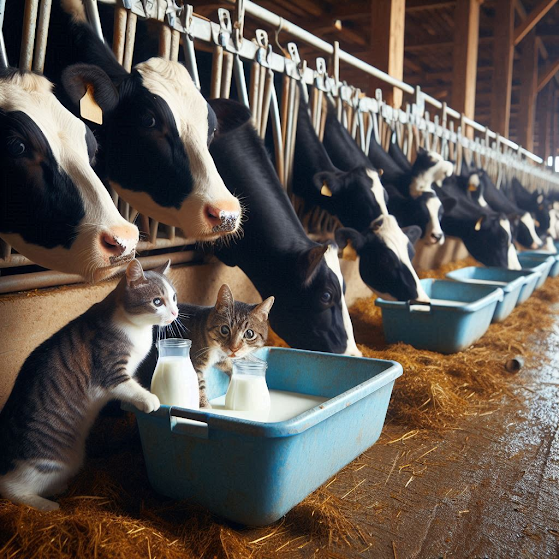 |
| Barn cats drink unpasteurised milk in a milking barn and caught bird flu which killed them. This is a fictional image please note based on the image on the internet. |
Autopsies were carried out on the cats some of whom had died in as little as two days after they fell ill. The virus had spread to their entire body, lungs, brains, heart and eyes.
It also believed the cats contracted the disease from infected cattle by being in close contact with them. Clearly, the disease is a zoonosis (zoonotic disease) because it is transferable from one species of animal to another.
The disease can be transmitted in saliva, droppings and other body fluids and as mentioned in consuming raw milk (colostrum) from the cows.
CDC obtained the bodies of two of the cats as well as samples of milk from the cows. They also examined tissue samples from six of the cows. Three of the cows were euthanized and three had died of the virus.
It appears that the symptoms were first observed in the cats and so CDC tested the cows in which they found symptoms including tiny lesions in their memory glands.
The situation with avian flu designated A(H5N1) has become serious in America. It first emerged in 1996 but since 2020 the number of outbreaks has increased rapidly with tens of millions of poultry killed and wild birds and land and marine animals also infected.
Being a zoonosis, the disease can be transferred to people and earlier in the month a dairy farm worker in Texas became the second American to become infected with the virus. The farmworker contracted a mild infection with just one symptom which was an inflammation of the eye and recovered well. They were placed into isolation.
It is believed that they didn't transfer the disease to others and were being treated with the drug Tamiflu. This occurred in Texas as well and is believed to be the first case of a human infected by avian influenza from a cow.
The virus is mutating making it easier to jump posts as happened with the Covid-19 virus.
Protections
Cats can be protected from A(H5N1) if they are given a vaccination. However, it’s important to note that cats can still shed some of the virus, albeit in low numbers. If a cat is exhibiting symptoms, it should be put into isolation and kept indoors. Then, it should be taken to a vet for testing to determine the presence of H5N1. Additionally, here are some other preventive measures for cat owners:
Limit Contact with Possible Vectors: To prevent the spread of H5N1 among cats, limit their contact with other possible vectors such as birds and cattle. Cats should also avoid contact with fomites, such as milking equipment.
Avoid Unpasteurized Milk: Do not allow cats to drink unpasteurized milk, as this could be a potential source of infection.
Minimize Unnecessary Contact: If highly pathogenic influenza viruses are found or suspected in a cat, minimize unnecessary contact. Use gloves, a mask, and goggles for protection when handling the cat.
Remember that while the risk of cat-to-human transmission of influenza is low, taking precautions is essential to protect both cats and humans. If you suspect your cat may have been exposed to A(H5N1), consult with a veterinarian promptly.



No comments:
Post a Comment
Your comments are always welcome.